HC2121 Comparative Business Ethics: Gender Pay Gap in Australia
VerifiedAdded on 2023/03/23
|8
|2338
|65
Essay
AI Summary
This essay provides a comparative analysis of business ethics in relation to the gender pay gap in Australia, focusing on the unethical issues faced by female employees and the historical context of legal efforts to address this disparity. It examines the application of utilitarian and deontological ethical theories, highlighting the marginalization of women and the need for fair treatment and equal pay. The essay also discusses the role of CSR initiatives and the implementation of acts like the Fair Works Commission in safeguarding women's rights and promoting gender equality in the workplace. The solution provides an overview of cases related to pay raises for early childhood educators, and the importance of ethical decision-making approaches like the Common Good and Virtue approaches in maintaining ethical conduct within organizations. Concluding with the necessity for collective responsibility and open opportunities for women in higher-paying positions to minimize the gender pay gap.
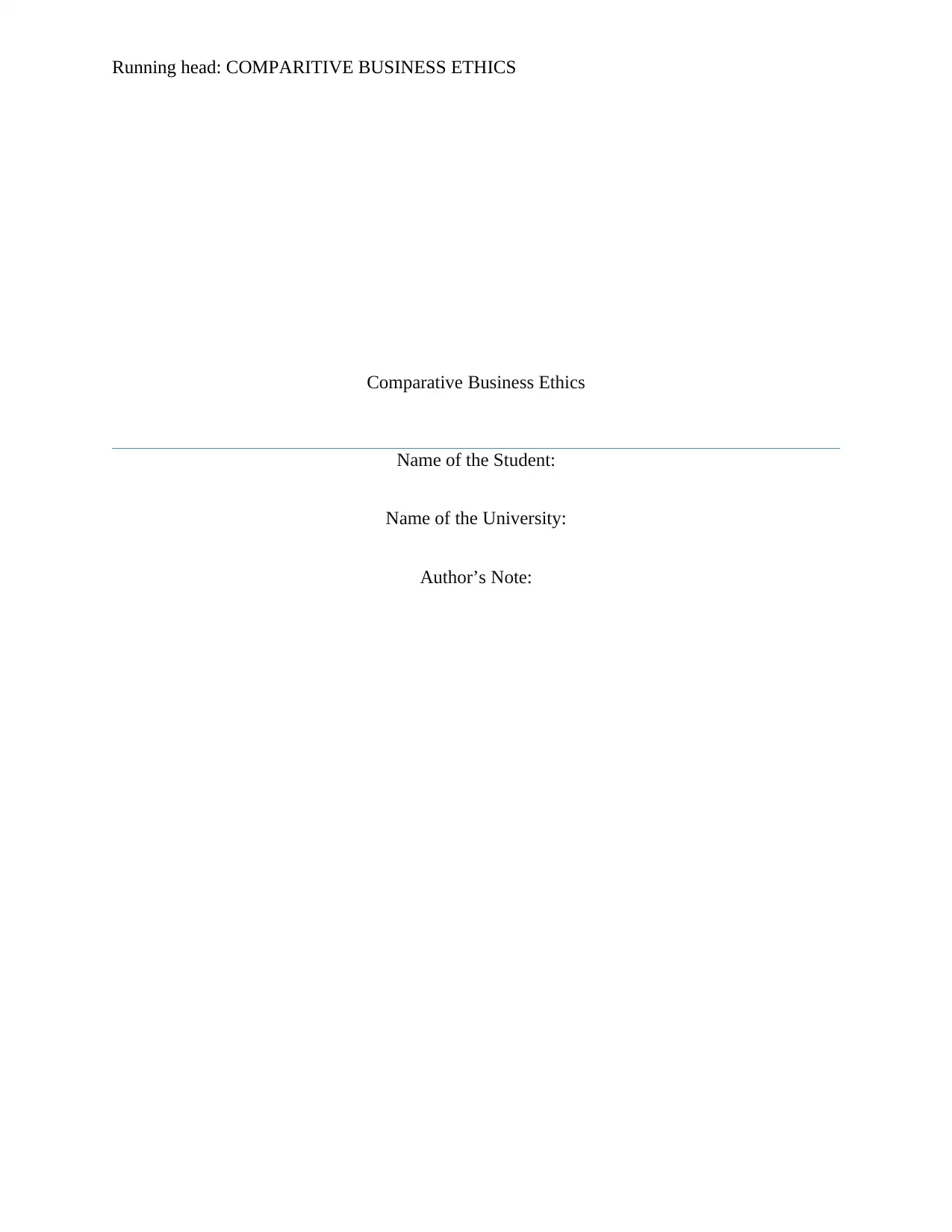
Running head: COMPARITIVE BUSINESS ETHICS
Comparative Business Ethics
Name of the Student:
Name of the University:
Author’s Note:
Comparative Business Ethics
Name of the Student:
Name of the University:
Author’s Note:
Paraphrase This Document
Need a fresh take? Get an instant paraphrase of this document with our AI Paraphraser
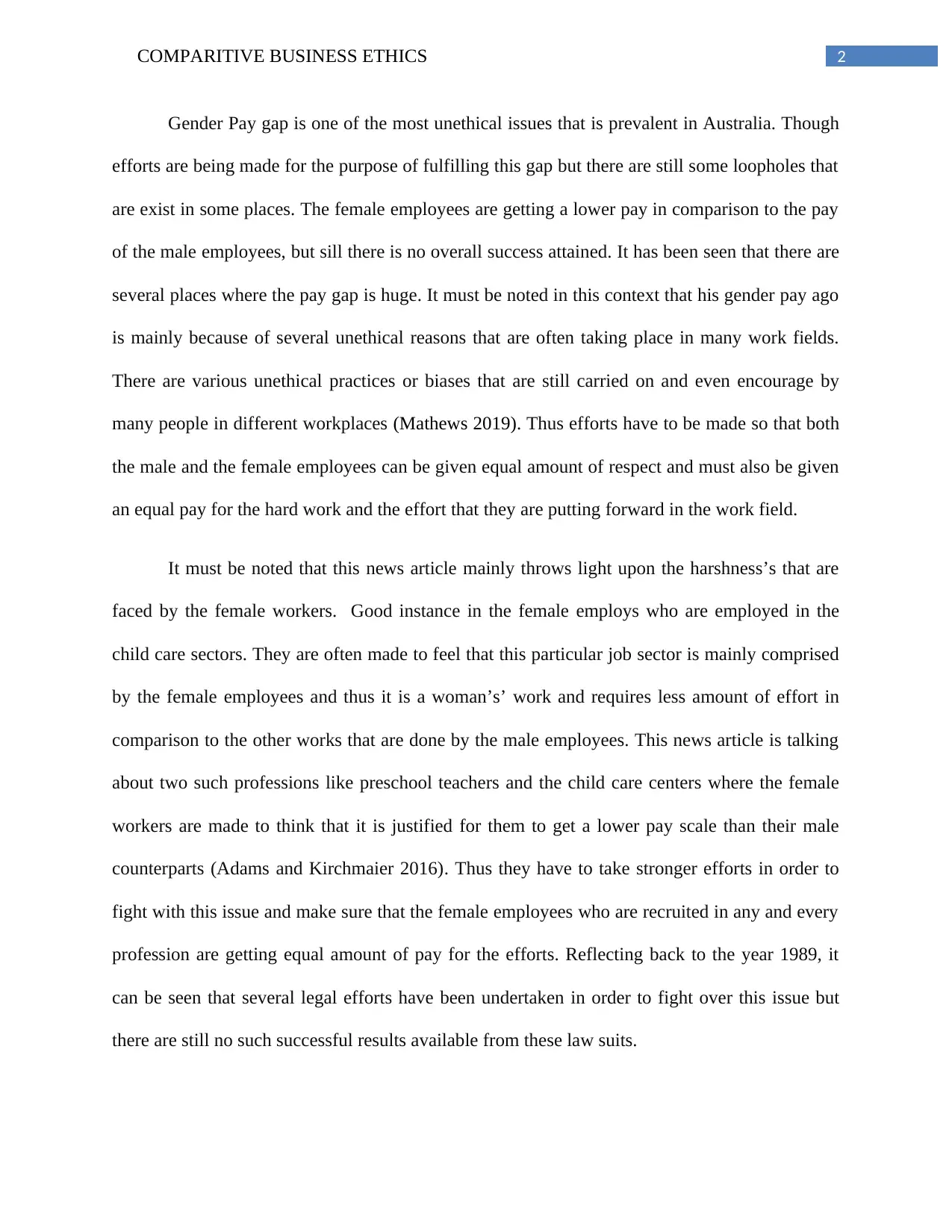
2COMPARITIVE BUSINESS ETHICS
Gender Pay gap is one of the most unethical issues that is prevalent in Australia. Though
efforts are being made for the purpose of fulfilling this gap but there are still some loopholes that
are exist in some places. The female employees are getting a lower pay in comparison to the pay
of the male employees, but sill there is no overall success attained. It has been seen that there are
several places where the pay gap is huge. It must be noted in this context that his gender pay ago
is mainly because of several unethical reasons that are often taking place in many work fields.
There are various unethical practices or biases that are still carried on and even encourage by
many people in different workplaces (Mathews 2019). Thus efforts have to be made so that both
the male and the female employees can be given equal amount of respect and must also be given
an equal pay for the hard work and the effort that they are putting forward in the work field.
It must be noted that this news article mainly throws light upon the harshness’s that are
faced by the female workers. Good instance in the female employs who are employed in the
child care sectors. They are often made to feel that this particular job sector is mainly comprised
by the female employees and thus it is a woman’s’ work and requires less amount of effort in
comparison to the other works that are done by the male employees. This news article is talking
about two such professions like preschool teachers and the child care centers where the female
workers are made to think that it is justified for them to get a lower pay scale than their male
counterparts (Adams and Kirchmaier 2016). Thus they have to take stronger efforts in order to
fight with this issue and make sure that the female employees who are recruited in any and every
profession are getting equal amount of pay for the efforts. Reflecting back to the year 1989, it
can be seen that several legal efforts have been undertaken in order to fight over this issue but
there are still no such successful results available from these law suits.
Gender Pay gap is one of the most unethical issues that is prevalent in Australia. Though
efforts are being made for the purpose of fulfilling this gap but there are still some loopholes that
are exist in some places. The female employees are getting a lower pay in comparison to the pay
of the male employees, but sill there is no overall success attained. It has been seen that there are
several places where the pay gap is huge. It must be noted in this context that his gender pay ago
is mainly because of several unethical reasons that are often taking place in many work fields.
There are various unethical practices or biases that are still carried on and even encourage by
many people in different workplaces (Mathews 2019). Thus efforts have to be made so that both
the male and the female employees can be given equal amount of respect and must also be given
an equal pay for the hard work and the effort that they are putting forward in the work field.
It must be noted that this news article mainly throws light upon the harshness’s that are
faced by the female workers. Good instance in the female employs who are employed in the
child care sectors. They are often made to feel that this particular job sector is mainly comprised
by the female employees and thus it is a woman’s’ work and requires less amount of effort in
comparison to the other works that are done by the male employees. This news article is talking
about two such professions like preschool teachers and the child care centers where the female
workers are made to think that it is justified for them to get a lower pay scale than their male
counterparts (Adams and Kirchmaier 2016). Thus they have to take stronger efforts in order to
fight with this issue and make sure that the female employees who are recruited in any and every
profession are getting equal amount of pay for the efforts. Reflecting back to the year 1989, it
can be seen that several legal efforts have been undertaken in order to fight over this issue but
there are still no such successful results available from these law suits.
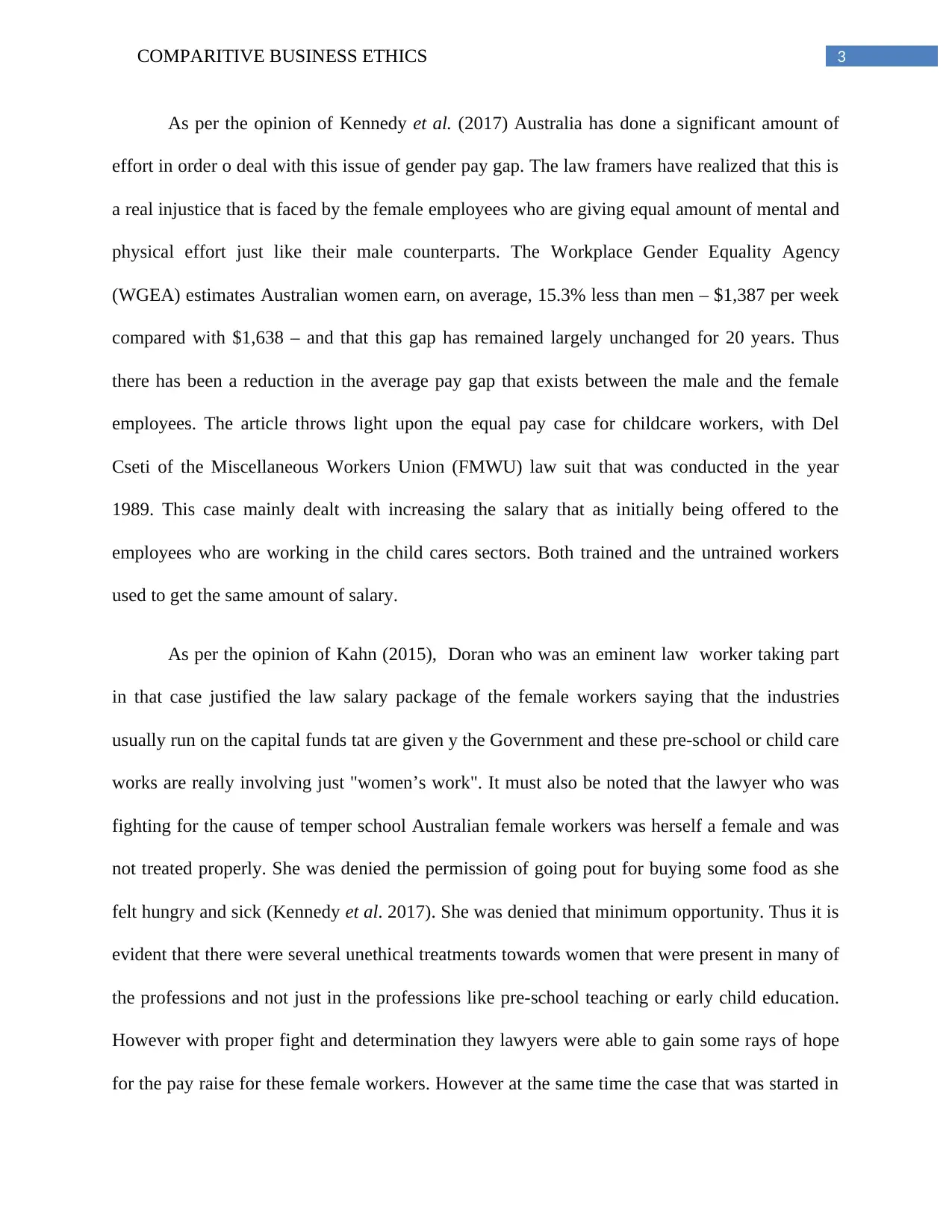
3COMPARITIVE BUSINESS ETHICS
As per the opinion of Kennedy et al. (2017) Australia has done a significant amount of
effort in order o deal with this issue of gender pay gap. The law framers have realized that this is
a real injustice that is faced by the female employees who are giving equal amount of mental and
physical effort just like their male counterparts. The Workplace Gender Equality Agency
(WGEA) estimates Australian women earn, on average, 15.3% less than men – $1,387 per week
compared with $1,638 – and that this gap has remained largely unchanged for 20 years. Thus
there has been a reduction in the average pay gap that exists between the male and the female
employees. The article throws light upon the equal pay case for childcare workers, with Del
Cseti of the Miscellaneous Workers Union (FMWU) law suit that was conducted in the year
1989. This case mainly dealt with increasing the salary that as initially being offered to the
employees who are working in the child cares sectors. Both trained and the untrained workers
used to get the same amount of salary.
As per the opinion of Kahn (2015), Doran who was an eminent law worker taking part
in that case justified the law salary package of the female workers saying that the industries
usually run on the capital funds tat are given y the Government and these pre-school or child care
works are really involving just "women’s work". It must also be noted that the lawyer who was
fighting for the cause of temper school Australian female workers was herself a female and was
not treated properly. She was denied the permission of going pout for buying some food as she
felt hungry and sick (Kennedy et al. 2017). She was denied that minimum opportunity. Thus it is
evident that there were several unethical treatments towards women that were present in many of
the professions and not just in the professions like pre-school teaching or early child education.
However with proper fight and determination they lawyers were able to gain some rays of hope
for the pay raise for these female workers. However at the same time the case that was started in
As per the opinion of Kennedy et al. (2017) Australia has done a significant amount of
effort in order o deal with this issue of gender pay gap. The law framers have realized that this is
a real injustice that is faced by the female employees who are giving equal amount of mental and
physical effort just like their male counterparts. The Workplace Gender Equality Agency
(WGEA) estimates Australian women earn, on average, 15.3% less than men – $1,387 per week
compared with $1,638 – and that this gap has remained largely unchanged for 20 years. Thus
there has been a reduction in the average pay gap that exists between the male and the female
employees. The article throws light upon the equal pay case for childcare workers, with Del
Cseti of the Miscellaneous Workers Union (FMWU) law suit that was conducted in the year
1989. This case mainly dealt with increasing the salary that as initially being offered to the
employees who are working in the child cares sectors. Both trained and the untrained workers
used to get the same amount of salary.
As per the opinion of Kahn (2015), Doran who was an eminent law worker taking part
in that case justified the law salary package of the female workers saying that the industries
usually run on the capital funds tat are given y the Government and these pre-school or child care
works are really involving just "women’s work". It must also be noted that the lawyer who was
fighting for the cause of temper school Australian female workers was herself a female and was
not treated properly. She was denied the permission of going pout for buying some food as she
felt hungry and sick (Kennedy et al. 2017). She was denied that minimum opportunity. Thus it is
evident that there were several unethical treatments towards women that were present in many of
the professions and not just in the professions like pre-school teaching or early child education.
However with proper fight and determination they lawyers were able to gain some rays of hope
for the pay raise for these female workers. However at the same time the case that was started in
⊘ This is a preview!⊘
Do you want full access?
Subscribe today to unlock all pages.

Trusted by 1+ million students worldwide
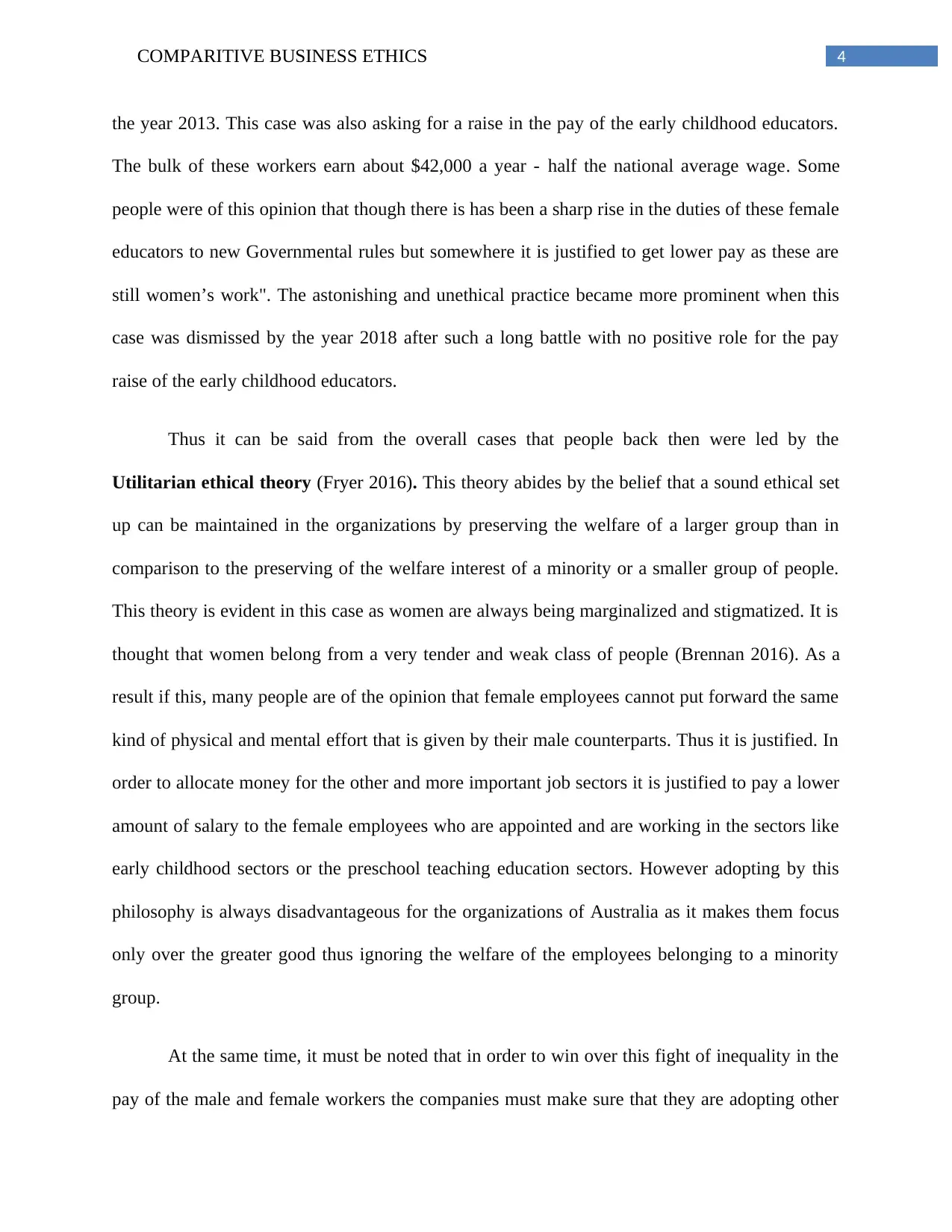
4COMPARITIVE BUSINESS ETHICS
the year 2013. This case was also asking for a raise in the pay of the early childhood educators.
The bulk of these workers earn about $42,000 a year - half the national average wage. Some
people were of this opinion that though there is has been a sharp rise in the duties of these female
educators to new Governmental rules but somewhere it is justified to get lower pay as these are
still women’s work". The astonishing and unethical practice became more prominent when this
case was dismissed by the year 2018 after such a long battle with no positive role for the pay
raise of the early childhood educators.
Thus it can be said from the overall cases that people back then were led by the
Utilitarian ethical theory (Fryer 2016). This theory abides by the belief that a sound ethical set
up can be maintained in the organizations by preserving the welfare of a larger group than in
comparison to the preserving of the welfare interest of a minority or a smaller group of people.
This theory is evident in this case as women are always being marginalized and stigmatized. It is
thought that women belong from a very tender and weak class of people (Brennan 2016). As a
result if this, many people are of the opinion that female employees cannot put forward the same
kind of physical and mental effort that is given by their male counterparts. Thus it is justified. In
order to allocate money for the other and more important job sectors it is justified to pay a lower
amount of salary to the female employees who are appointed and are working in the sectors like
early childhood sectors or the preschool teaching education sectors. However adopting by this
philosophy is always disadvantageous for the organizations of Australia as it makes them focus
only over the greater good thus ignoring the welfare of the employees belonging to a minority
group.
At the same time, it must be noted that in order to win over this fight of inequality in the
pay of the male and female workers the companies must make sure that they are adopting other
the year 2013. This case was also asking for a raise in the pay of the early childhood educators.
The bulk of these workers earn about $42,000 a year - half the national average wage. Some
people were of this opinion that though there is has been a sharp rise in the duties of these female
educators to new Governmental rules but somewhere it is justified to get lower pay as these are
still women’s work". The astonishing and unethical practice became more prominent when this
case was dismissed by the year 2018 after such a long battle with no positive role for the pay
raise of the early childhood educators.
Thus it can be said from the overall cases that people back then were led by the
Utilitarian ethical theory (Fryer 2016). This theory abides by the belief that a sound ethical set
up can be maintained in the organizations by preserving the welfare of a larger group than in
comparison to the preserving of the welfare interest of a minority or a smaller group of people.
This theory is evident in this case as women are always being marginalized and stigmatized. It is
thought that women belong from a very tender and weak class of people (Brennan 2016). As a
result if this, many people are of the opinion that female employees cannot put forward the same
kind of physical and mental effort that is given by their male counterparts. Thus it is justified. In
order to allocate money for the other and more important job sectors it is justified to pay a lower
amount of salary to the female employees who are appointed and are working in the sectors like
early childhood sectors or the preschool teaching education sectors. However adopting by this
philosophy is always disadvantageous for the organizations of Australia as it makes them focus
only over the greater good thus ignoring the welfare of the employees belonging to a minority
group.
At the same time, it must be noted that in order to win over this fight of inequality in the
pay of the male and female workers the companies must make sure that they are adopting other
Paraphrase This Document
Need a fresh take? Get an instant paraphrase of this document with our AI Paraphraser
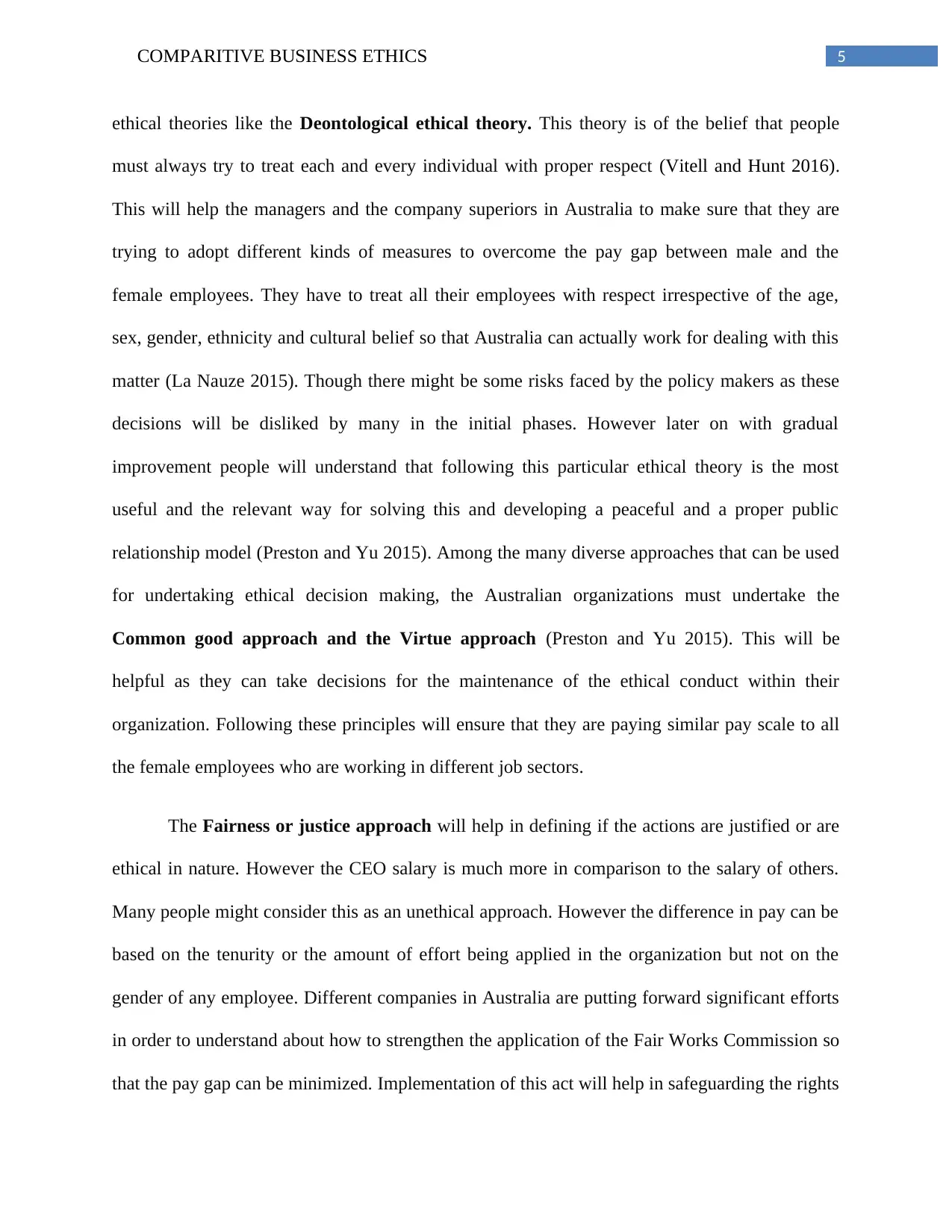
5COMPARITIVE BUSINESS ETHICS
ethical theories like the Deontological ethical theory. This theory is of the belief that people
must always try to treat each and every individual with proper respect (Vitell and Hunt 2016).
This will help the managers and the company superiors in Australia to make sure that they are
trying to adopt different kinds of measures to overcome the pay gap between male and the
female employees. They have to treat all their employees with respect irrespective of the age,
sex, gender, ethnicity and cultural belief so that Australia can actually work for dealing with this
matter (La Nauze 2015). Though there might be some risks faced by the policy makers as these
decisions will be disliked by many in the initial phases. However later on with gradual
improvement people will understand that following this particular ethical theory is the most
useful and the relevant way for solving this and developing a peaceful and a proper public
relationship model (Preston and Yu 2015). Among the many diverse approaches that can be used
for undertaking ethical decision making, the Australian organizations must undertake the
Common good approach and the Virtue approach (Preston and Yu 2015). This will be
helpful as they can take decisions for the maintenance of the ethical conduct within their
organization. Following these principles will ensure that they are paying similar pay scale to all
the female employees who are working in different job sectors.
The Fairness or justice approach will help in defining if the actions are justified or are
ethical in nature. However the CEO salary is much more in comparison to the salary of others.
Many people might consider this as an unethical approach. However the difference in pay can be
based on the tenurity or the amount of effort being applied in the organization but not on the
gender of any employee. Different companies in Australia are putting forward significant efforts
in order to understand about how to strengthen the application of the Fair Works Commission so
that the pay gap can be minimized. Implementation of this act will help in safeguarding the rights
ethical theories like the Deontological ethical theory. This theory is of the belief that people
must always try to treat each and every individual with proper respect (Vitell and Hunt 2016).
This will help the managers and the company superiors in Australia to make sure that they are
trying to adopt different kinds of measures to overcome the pay gap between male and the
female employees. They have to treat all their employees with respect irrespective of the age,
sex, gender, ethnicity and cultural belief so that Australia can actually work for dealing with this
matter (La Nauze 2015). Though there might be some risks faced by the policy makers as these
decisions will be disliked by many in the initial phases. However later on with gradual
improvement people will understand that following this particular ethical theory is the most
useful and the relevant way for solving this and developing a peaceful and a proper public
relationship model (Preston and Yu 2015). Among the many diverse approaches that can be used
for undertaking ethical decision making, the Australian organizations must undertake the
Common good approach and the Virtue approach (Preston and Yu 2015). This will be
helpful as they can take decisions for the maintenance of the ethical conduct within their
organization. Following these principles will ensure that they are paying similar pay scale to all
the female employees who are working in different job sectors.
The Fairness or justice approach will help in defining if the actions are justified or are
ethical in nature. However the CEO salary is much more in comparison to the salary of others.
Many people might consider this as an unethical approach. However the difference in pay can be
based on the tenurity or the amount of effort being applied in the organization but not on the
gender of any employee. Different companies in Australia are putting forward significant efforts
in order to understand about how to strengthen the application of the Fair Works Commission so
that the pay gap can be minimized. Implementation of this act will help in safeguarding the rights
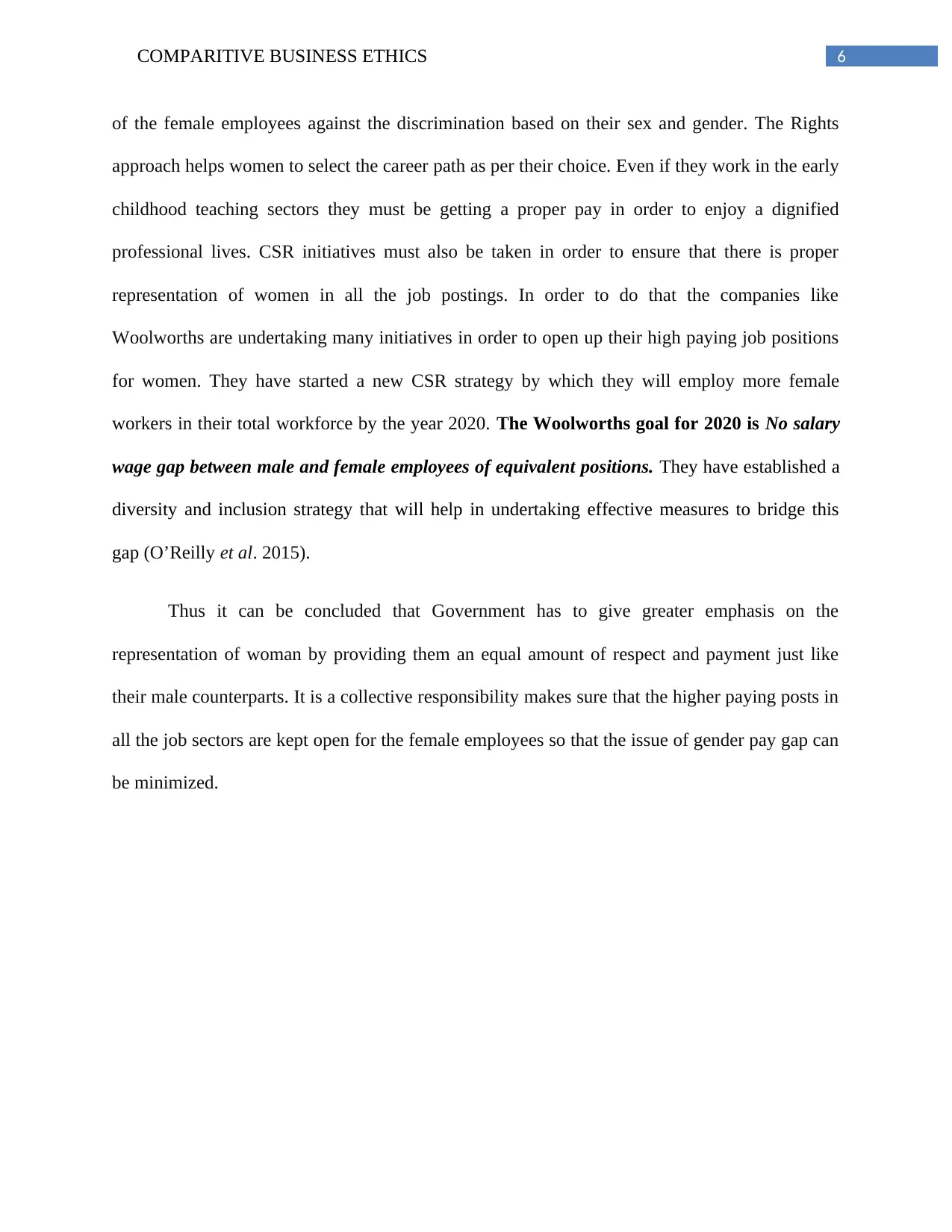
6COMPARITIVE BUSINESS ETHICS
of the female employees against the discrimination based on their sex and gender. The Rights
approach helps women to select the career path as per their choice. Even if they work in the early
childhood teaching sectors they must be getting a proper pay in order to enjoy a dignified
professional lives. CSR initiatives must also be taken in order to ensure that there is proper
representation of women in all the job postings. In order to do that the companies like
Woolworths are undertaking many initiatives in order to open up their high paying job positions
for women. They have started a new CSR strategy by which they will employ more female
workers in their total workforce by the year 2020. The Woolworths goal for 2020 is No salary
wage gap between male and female employees of equivalent positions. They have established a
diversity and inclusion strategy that will help in undertaking effective measures to bridge this
gap (O’Reilly et al. 2015).
Thus it can be concluded that Government has to give greater emphasis on the
representation of woman by providing them an equal amount of respect and payment just like
their male counterparts. It is a collective responsibility makes sure that the higher paying posts in
all the job sectors are kept open for the female employees so that the issue of gender pay gap can
be minimized.
of the female employees against the discrimination based on their sex and gender. The Rights
approach helps women to select the career path as per their choice. Even if they work in the early
childhood teaching sectors they must be getting a proper pay in order to enjoy a dignified
professional lives. CSR initiatives must also be taken in order to ensure that there is proper
representation of women in all the job postings. In order to do that the companies like
Woolworths are undertaking many initiatives in order to open up their high paying job positions
for women. They have started a new CSR strategy by which they will employ more female
workers in their total workforce by the year 2020. The Woolworths goal for 2020 is No salary
wage gap between male and female employees of equivalent positions. They have established a
diversity and inclusion strategy that will help in undertaking effective measures to bridge this
gap (O’Reilly et al. 2015).
Thus it can be concluded that Government has to give greater emphasis on the
representation of woman by providing them an equal amount of respect and payment just like
their male counterparts. It is a collective responsibility makes sure that the higher paying posts in
all the job sectors are kept open for the female employees so that the issue of gender pay gap can
be minimized.
⊘ This is a preview!⊘
Do you want full access?
Subscribe today to unlock all pages.

Trusted by 1+ million students worldwide
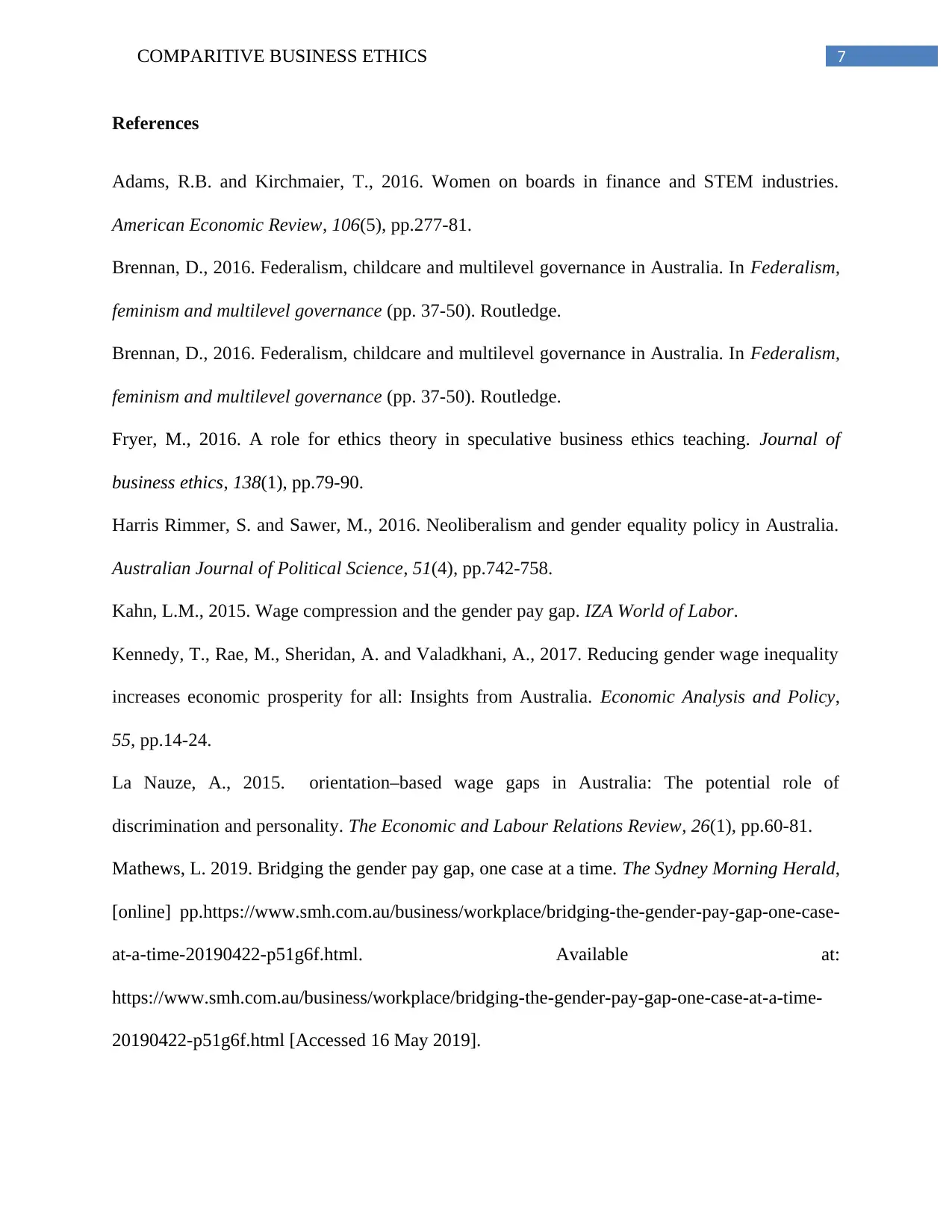
7COMPARITIVE BUSINESS ETHICS
References
Adams, R.B. and Kirchmaier, T., 2016. Women on boards in finance and STEM industries.
American Economic Review, 106(5), pp.277-81.
Brennan, D., 2016. Federalism, childcare and multilevel governance in Australia. In Federalism,
feminism and multilevel governance (pp. 37-50). Routledge.
Brennan, D., 2016. Federalism, childcare and multilevel governance in Australia. In Federalism,
feminism and multilevel governance (pp. 37-50). Routledge.
Fryer, M., 2016. A role for ethics theory in speculative business ethics teaching. Journal of
business ethics, 138(1), pp.79-90.
Harris Rimmer, S. and Sawer, M., 2016. Neoliberalism and gender equality policy in Australia.
Australian Journal of Political Science, 51(4), pp.742-758.
Kahn, L.M., 2015. Wage compression and the gender pay gap. IZA World of Labor.
Kennedy, T., Rae, M., Sheridan, A. and Valadkhani, A., 2017. Reducing gender wage inequality
increases economic prosperity for all: Insights from Australia. Economic Analysis and Policy,
55, pp.14-24.
La Nauze, A., 2015. orientation–based wage gaps in Australia: The potential role of
discrimination and personality. The Economic and Labour Relations Review, 26(1), pp.60-81.
Mathews, L. 2019. Bridging the gender pay gap, one case at a time. The Sydney Morning Herald,
[online] pp.https://www.smh.com.au/business/workplace/bridging-the-gender-pay-gap-one-case-
at-a-time-20190422-p51g6f.html. Available at:
https://www.smh.com.au/business/workplace/bridging-the-gender-pay-gap-one-case-at-a-time-
20190422-p51g6f.html [Accessed 16 May 2019].
References
Adams, R.B. and Kirchmaier, T., 2016. Women on boards in finance and STEM industries.
American Economic Review, 106(5), pp.277-81.
Brennan, D., 2016. Federalism, childcare and multilevel governance in Australia. In Federalism,
feminism and multilevel governance (pp. 37-50). Routledge.
Brennan, D., 2016. Federalism, childcare and multilevel governance in Australia. In Federalism,
feminism and multilevel governance (pp. 37-50). Routledge.
Fryer, M., 2016. A role for ethics theory in speculative business ethics teaching. Journal of
business ethics, 138(1), pp.79-90.
Harris Rimmer, S. and Sawer, M., 2016. Neoliberalism and gender equality policy in Australia.
Australian Journal of Political Science, 51(4), pp.742-758.
Kahn, L.M., 2015. Wage compression and the gender pay gap. IZA World of Labor.
Kennedy, T., Rae, M., Sheridan, A. and Valadkhani, A., 2017. Reducing gender wage inequality
increases economic prosperity for all: Insights from Australia. Economic Analysis and Policy,
55, pp.14-24.
La Nauze, A., 2015. orientation–based wage gaps in Australia: The potential role of
discrimination and personality. The Economic and Labour Relations Review, 26(1), pp.60-81.
Mathews, L. 2019. Bridging the gender pay gap, one case at a time. The Sydney Morning Herald,
[online] pp.https://www.smh.com.au/business/workplace/bridging-the-gender-pay-gap-one-case-
at-a-time-20190422-p51g6f.html. Available at:
https://www.smh.com.au/business/workplace/bridging-the-gender-pay-gap-one-case-at-a-time-
20190422-p51g6f.html [Accessed 16 May 2019].
Paraphrase This Document
Need a fresh take? Get an instant paraphrase of this document with our AI Paraphraser
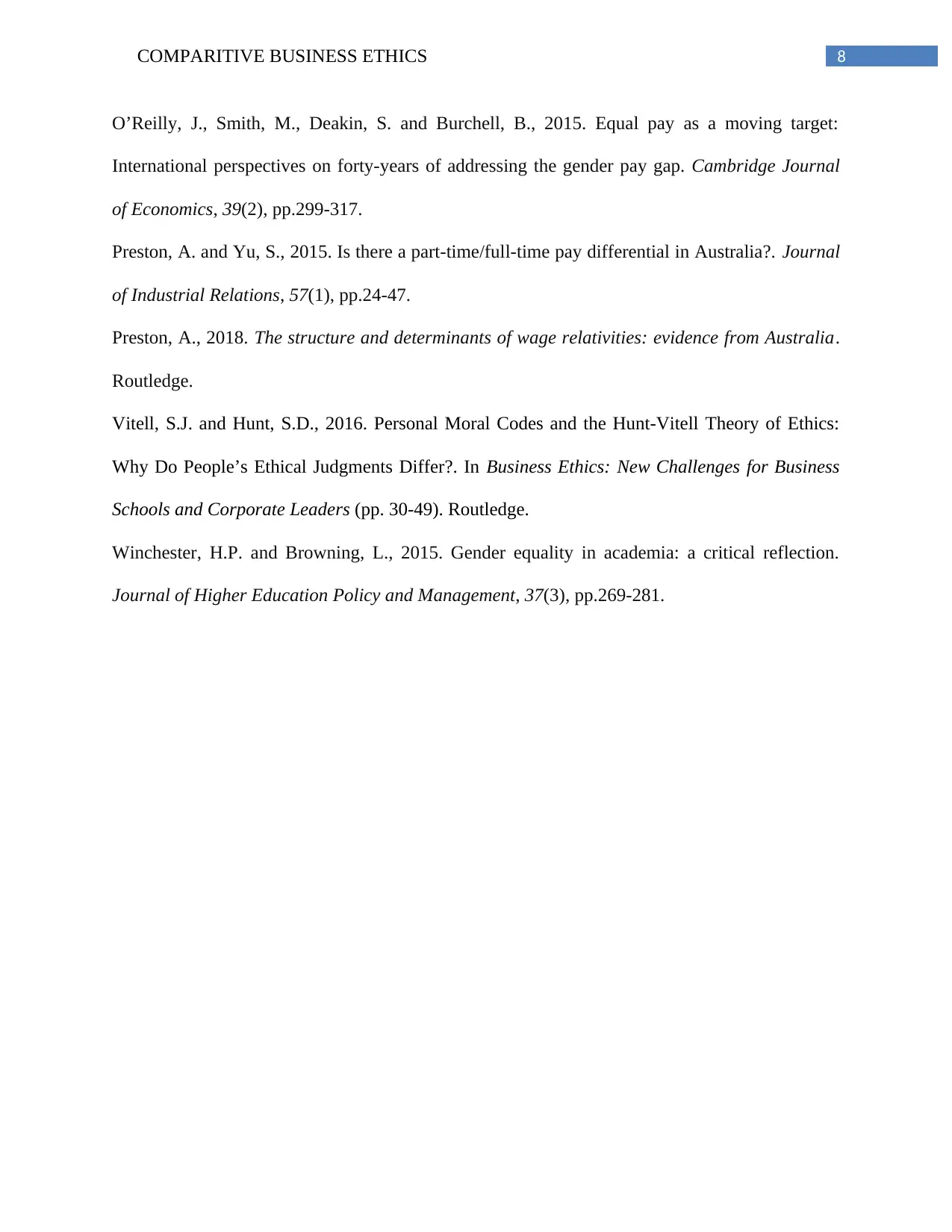
8COMPARITIVE BUSINESS ETHICS
O’Reilly, J., Smith, M., Deakin, S. and Burchell, B., 2015. Equal pay as a moving target:
International perspectives on forty-years of addressing the gender pay gap. Cambridge Journal
of Economics, 39(2), pp.299-317.
Preston, A. and Yu, S., 2015. Is there a part-time/full-time pay differential in Australia?. Journal
of Industrial Relations, 57(1), pp.24-47.
Preston, A., 2018. The structure and determinants of wage relativities: evidence from Australia.
Routledge.
Vitell, S.J. and Hunt, S.D., 2016. Personal Moral Codes and the Hunt-Vitell Theory of Ethics:
Why Do People’s Ethical Judgments Differ?. In Business Ethics: New Challenges for Business
Schools and Corporate Leaders (pp. 30-49). Routledge.
Winchester, H.P. and Browning, L., 2015. Gender equality in academia: a critical reflection.
Journal of Higher Education Policy and Management, 37(3), pp.269-281.
O’Reilly, J., Smith, M., Deakin, S. and Burchell, B., 2015. Equal pay as a moving target:
International perspectives on forty-years of addressing the gender pay gap. Cambridge Journal
of Economics, 39(2), pp.299-317.
Preston, A. and Yu, S., 2015. Is there a part-time/full-time pay differential in Australia?. Journal
of Industrial Relations, 57(1), pp.24-47.
Preston, A., 2018. The structure and determinants of wage relativities: evidence from Australia.
Routledge.
Vitell, S.J. and Hunt, S.D., 2016. Personal Moral Codes and the Hunt-Vitell Theory of Ethics:
Why Do People’s Ethical Judgments Differ?. In Business Ethics: New Challenges for Business
Schools and Corporate Leaders (pp. 30-49). Routledge.
Winchester, H.P. and Browning, L., 2015. Gender equality in academia: a critical reflection.
Journal of Higher Education Policy and Management, 37(3), pp.269-281.
1 out of 8
Related Documents
Your All-in-One AI-Powered Toolkit for Academic Success.
+13062052269
info@desklib.com
Available 24*7 on WhatsApp / Email
![[object Object]](/_next/static/media/star-bottom.7253800d.svg)
Unlock your academic potential
Copyright © 2020–2025 A2Z Services. All Rights Reserved. Developed and managed by ZUCOL.





